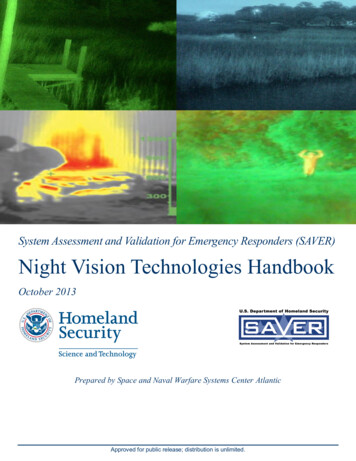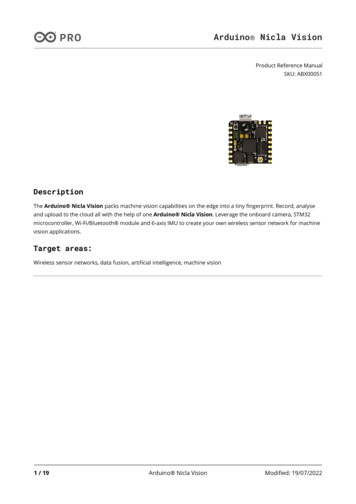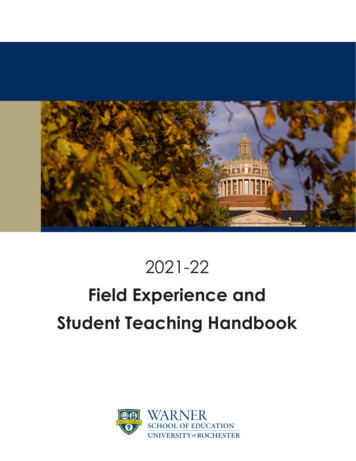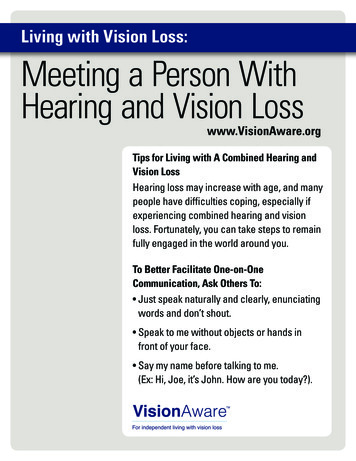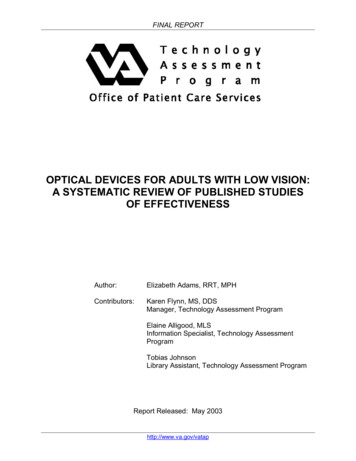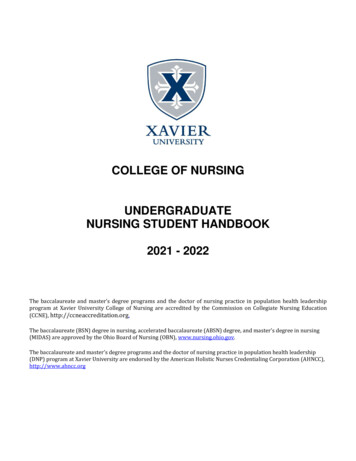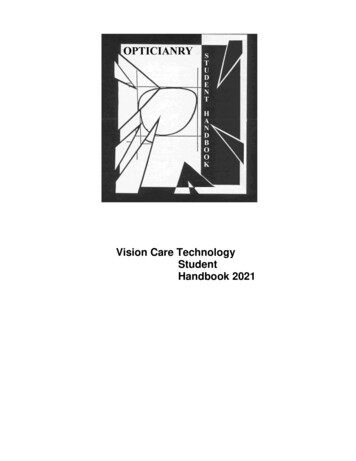
Transcription
Vision Care TechnologyStudentHandbook 2021
TABLE OF CONTENTSWELCOME AND FACULTY. 3WHO'S WHO IN VISION CARE . 4Ophthalmologist . 4Optometrist . 4Dispensing Optician . 4Ophthalmic Technician . 4-5Optometric Technician . 5Ophthalmic Laboratory Technician . 5Frame Stylist. 5OPTICIANRY . 6The Profession of Opticianry . 6Work Environment . 6Future Job Outlook . 6Why the Market is Right for Opticians . 6VISION CARE TECHNOLOGY PROGRAM . 7Description . 7Mission Statement . 8Program Goals . 8Program Objectives . 9Curriculum and Course description . 10-13Graduate Competencies . 14GENERAL PROCEDURES/REQUIREMENTS .15Entrance Requirements . 15Tuition and Fees . 15Financial Aid . 15Scholarship . 15Withdrawal Procedures . 15Refund Policy . 15Health Guidelines . 15Malpractice Insurance . 16Medical Emergency on Campus . 16Emergency procedure . 16Grading Policies . 16Attendance Policy. 17Food and Drink policy . 17Cell Phone and Pager Policy . 17Alcoholic Beverages . 17Drug-Free Environment . 17
Disruptive Conduct . 18Smoking and Tobacco Products . 18OPHTHALMIC DISPENSING CLINIC .19Professional Appearance and Grooming . 19Professional Conduct . 19Other Clinic Conduct Rules . 19Student Patient Communication . 19Required Supplies. 20Student Lab Manager . 20Student Optician . 20-21LABORATORY SAFETY PROCEDURES .22Ophthalmic Laboratory Regulations . 22Infection Control tips on Hand washing. 22Hand washing Steps . 22-23Infectious Disease Control Policy . 24STUDENT APPEALS . 25-26STUDENT OPTICAL SOCIETY BY-LAWS . 27-30TN LICENSING REQUIREMENTS FOR OPTICIANS.31PROFESSIONAL ORGANIZATIONS . 32-34Tennessee Dispensing Opticians Association . 32Tennessee State Board of Dispensing Opticians . 32Opticians Association of America . 32National Academy of Opticianry. 32The American Board of Opticianry and National ContactLens Examiners . 33The Contact Lens Society of America. 33The Commission on Opticianry Accreditation . 33The National Federation of Opticianry Schools . 33The Optical Laboratories Association . 34Opticians Association of Tennessee . 34Code of Ethics .35RSCC LIBRARY REFERENCE MATERIAL . 36-37Periodicals . 36Books . 36-37SIGNATURE SHEETS .38-42Criminal Back Ground Check . 38
Drug/Alcohol Testing . 39ABO and NCLE Release Form . 40Academic Misconduct Agreement . 41Student Signature . 42
WELCOME TO THE VISION CARE TECHNOLOGY PROGRAMWelcome, and congratulations on your acceptance into the RSCC Vision Care Technology Program! We hopethat your college experience will be pleasant as well as beneficial. Use this handbook to familiarize yourselfwith the program and its requirements. If you need assistance of ANY kind, do not hesitate to ask your facultyadvisor or any of us.FACULTYLeigh Ann Hopson LDO, ProgramDirector (865) 354-3000 ext. 3606A.A.S., Roane State Community College-OpticianryCurrent, Tennessee Tech University –Interdisciplinary Studies – LeadershipLicensed OpticianABO CertificationMike Goggin LDO, Associate Professor- Post Retirement(865) 354-3000 ext. 4319A.A.S., Erie Community College-OpticianryB.A., State University of New York at Buffalo-AnthropologyLicensed OpticianMaster OpticianWHO'S WHO IN VISION CAREOPHTHALMOLOGIST (M.D)An ophthalmologist is a physician who specializes in comprehensive care of the eyes and visual system. Theophthalmologist is a medically trained specialist qualified to diagnose and treat all eye and visual systemproblems. Each is licensed by a state to practice medicine and surgery. The ophthalmologist has completed twoto four years of college premedical training, four years of medical school, one year of internship, and threeyears of residency; some have additional years of fellowship.OPTOMETRIST (O.D.)Doctors of optometry (optometrists) are professionals who are specifically educated, clinically trained and statelicensed to examine the eyes and visual system, diagnose problems or impairments and prescribe and providetreatment. Among the types of treatment optometrists use are prescription glasses, contact lenses, visiontherapy, low-vision aids, and in many states, pharmaceutical agents.After a minimum of two to four years of undergraduate training, optometrists pursue a four-year professionaldegree program involving specialized classroom and clinical training in all phases of functional vision care,optics, and eye health.DISPENSING OPTICIAN (L.D.O. or R.D.O)A licensed dispensing optician is a professional who designs, verifies and delivers spectacle lenses, frames andother specially fabricated optical devices and/or contact lenses upon prescription to the intended wearer. Theoptician's functions include prescription analysis and interpretation; frame selection; determination of the lens
forms best suited to the wearer's needs; preparation and delivery of work orders for surfacing of lenses andfabrication of eyewear; verification of the finished ophthalmic products; adjustment, replacement, repair, andreproduction of previously prepared ophthalmic lenses, frames and other specifically fabricated ophthalmicdevices.OPHTHALMIC TECHNICIAN (C.O.T.)A certified ophthalmic technician is a professional who performs medical histories, pre-test to access visualfunction, specialized tests to determine specific eye diseases and office management for the ophthalmologists(medical doctor). The ophthalmic technician needs to understand the anatomy of the eye and how the eyefunctions. This will include knowledge and recognition of common eye diseases. Communication skills areutilized to obtain relevant medical histories and to efficiently convey eyecare information to patients.Ophthalmic technicians also help administer eye medications and dressings, and assist in minor officesurgeries.OPTOMETRIC TECHNICIANA paraoptometric is able to perform various specialized skills, including clinical data collection, ophthalmicfabrication and ophthalmic dispensing under the direct supervision of an optometrists.OPHTHALMIC LABORATORY TECHNICIANThe technician operates machinery to grind lenses and fabricate eyewear to prescription in an ophthalmiclaboratory.FRAME STYLISTA person trained to help a client select a frame for good fit and cosmetic appearance. Usually employed in alarge retail optical stores. Their training consists of on the job training.
OPTICIANRYTHE PROFESSION OF OPTICIANRYOpticians are professionals who design and fit eyeglasses, contact lenses and other specialized optical devices.The patient brings the optician a prescription from their doctor and the optician determines the best way to fillthat prescription. There are hundreds of ways to fill any given prescription. There are many different frame andlens materials, lens designs, colors, coatings, frame fashions and other add-ons. Opticians select the best ofthese options for each patient based on his or her visual, fashion, and financial needs. The optician considersmany patient variables; their prescription, the type of work they do, their hobbies, sports they play and otherspecial visual considerations. Opticians need to make sure their patients see clearly, look attractive (opticiansare also fashion consultants), and have properly adjusted and comfortable glasses that fit conveniently intotheir lifestyle.WORK ENVIRONMENTMost opticians work in retail business settings and medical offices, selling eyewear directly to the public.However, some specialize in areas such as contact lens fitting, laboratory work, or as sales representatives forframe and lens manufacturers.FUTURE JOB OUTLOOKThere is a real demand for good opticians in the workplace. The profession is enjoyable and financiallyrewarding while providing real service to your patients. Opticians can work for themselves, for other privateopticians, ophthalmologists, optometrists, chain stores, laboratories or manufacturers. Because of this highdemand, opticians are also very mobile. If relocation is desired, it is fairly easy to secure a new job in any partof the country.Why the market is right for opticiansThere are several reasons why people are buying glasses and contact lenses now more than ever before andwhy sales continue to rise. People used to have only one pair of glasses. Today they are buying many pairsbased on fashion. Some customers buy new glasses to match each new outfit. Many of the frames today have arecognizable logo or designer's name and are advertised in high fashion magazines. Opticians also sell multiplepairs of glasses based on lifestyle. Many patients now have a specialized pair of glasses for different activities,such as working with the computer, fishing, skiing, dressing up, reading, swimming, racquetball, safety jobsand other special applications. Many people are moving into the age bracket where they lose the ability to seesmall print and focus at near distances. This alone will create a need for specialized eyewear.
VISION CARE TECHNOLOGY PROGRAMDESCRIPTIONVision Care Technology program is a two-year associate of applied science degree career preparation program.Graduates of this program will be eligible to sit for the Tennessee State Board Examination in OphthalmicDispensing and the national board certification examinations. The total educational program will includegeneral studies, technical, and fieldwork components.The Opticianry program is nationally accredited by the Commission on Opticianry Accreditation.Admission to the program is required prior to enrolling in any VECT courses. Courses must be taken insequence. All professional opticianry courses are taught at the main campus in Harriman. A student mustmaintain a minimum grade of C or better in all VECT courses in order to advance within the program.The successful completion of this program offers the graduate a challenging and rewarding career as a healthcare professional.Program Goals and ObjectivesMISSION STATEMENTThe Mission of the Roane State Community College Opticianry Program is to provide our students with apostsecondary education resulting in an Associate of Applied Science degree, and to provide society withqualified, conscientious and professional dispensing opticians.PROGRAM GOALSThe interests and welfare of the community, students, faculty, institution and the ophthalmic healthcare professions are satisfied by the attainment of the stated goals. The program goals are also consistent andcompatible with the stated goals of the Allied Health Science Division and Roane State Community College.1. Community Related Goalsa. Provide the ophthalmic community with a skilled graduate qualified by academic and clinical trainingto fulfill the duties and responsibilities of a Dispensing Optician.b. Promote cooperation among the health care delivery system ophthalmologists, optometrists,Opticians, and consumers in the recognition and full utilization of the graduate.c. Eliminate hazardous waste and to reduce non-hazardous waste to the minimum levelsEconomically, and technically practical, and to be in full-compliance with all federal and stateenvironmental regulations.2. Student Goalsa. Accomplish the educational objectives of each course and to fulfill the criteria used to evaluatestudent success.b. Develop the professional attitudes and discipline necessary for success in the ophthalmic health careprofessions.c. Successfully complete the ABO, NCLE and Tennessee State licensing examinations.3. Faculty Goalsa. Provide teaching/learning experiences which develop knowledge, concepts, and understanding skillsfor opticianry through both formal and continuing education.
b.c.Pursue continuous and professional development in order to provide students the latest informationregarding ophthalmic innovations.Actively participate and assume leadership roles in local, state and national professionalorganizations and the college.PROGRAM OBJECTIVES1. Prepare all graduates for employment as opticians.2. Prepare all graduates to become licensed opticians3. Provide a learning experience that encompasses theoretical and practical knowledge leading to amarketable skill for the student in the career area.4. Prepare competent opticians to demonstrate professional and ethical behavior when interacting with clientsand other professionals, through employer and/or practicum feedback.5. Ensure that graduates will have general knowledge in the areas of communication, mathematics, socialscience and humanities, through the successful completion of the required general education core classes.6. To recruit and provide educational opportunities, in the discipline of opticianry, to the college communityregardless of sex, race, creed, age, marital status, national origin, handicaps or financial resources.
VISION CARE TECHNOLOGY (VECT)Associate of Applied ScienceDegree PlanBusiness Elective – 1 courseBUSN 1305 Introduction to BusinessACCT 1010 Principles of Accounting IBUSN 1330 EntrepreneurshipBUSN 1380 Supervisory ManagementALH 211Management and Leadership forAllied Health SupervisorsCommunication – 2 coursesENGL 1010 Comp ISPCH 1010 Fundamentals of SpeechHumanities/Fine Arts – 1 courseARTH 2010 Survey of Art History IARTH 2020 Survey of Art History IIARTH 1030 Art AppreciationENGL 2110 American Lit IENGL 2120 American Lit IIENGL 2210 British Lit IENGL 2220 British Lit IIENGL 2310 World Lit IENGL 2320 World Lit IIHUM 262Great Works-Intro to HumanitiesMUS 1030Music AppreciationTHEA 1030 Introduction to TheaterPHIL 1030Intro to PhilosophyPHIL 121Elementary EthicsPHIL 201Intro to Religions of WorldMathematics – 1 courseMATH 1130 College AlgebraMATH 1530 Probability and StatisticsMATH 1630 Finite MathMATH 1720 TrigonometryMATH 1730 Pre-CalculusMATH 1830 Basic CalculusMATH 1910 Calculus ISocial Science – 1 courseANTH 2150 Native American StudiesECON 2010 MacroeconomicsECON 2020 MicroeconomicsGEOG 1220 Human GeographyGEOG 2010INTL 1010POLS 1025POLS 1030PSYC 1030PSYC 2220PSYC 2130SOCI 1010SOCI 1020SOCI 2110SOCI 2120WELL 1010World Regional GeographyIntro to Global StudiesIntro to Political ScienceAmerican GovernmentGeneral PsychologyBiological Basis of BehaviorLifespan PsychologyIntro to SociologySocial ProblemsCultural AnthropologyPrehistoric ArchaeologyLifetime WellnessFirst YearFall SemesterVECT 1410 Introduction to Opticianry – 4creditsVECT 1430 Anatomy and Physiology of the Eye– 4 creditsSpring SemesterVECT 1420 Ophthalmic Dispensing I – 4 creditsVECT 1440 Ophthalmic Materials I – 4 creditsVECT 1330 Geometric Optics for Opticians – 3creditsVECT 1450 Contact Lenses I – 4 creditsSummer SemesterVECT 1140 Practicum – 1 creditSecond YearFall SemesterVECT 2410 Ophthalmic Dispensing II – 4 creditsVECT 2420 Ophthalmic Materials II – 4 creditsVECT 2430 Contact Lenses II – 4 creditsSpring SemesterVECT 1460 Ophthalmic Dispensing III – 4creditsVECT 1470 Ophthalmic Materials III – 4 creditsVECT 1480 Contact Lenses III – 4 credits
A certain number of credit hours in each program must be completed in order to meet the graduationresidency requirement. Contact your advisor for the requirement of your program.The Intent to Graduate form needs to be submitted to the Office of Graduation during the fall term ofthe second year.Revised 6/2019
Course DescriptionsVECT 1410 -- Introduction to Opticianry.4 creditsA general overview of the field of Opticianry, intended to provide the student with a broad base for moreadvanced study. Included is the history of Opticianry, the visual sense, basic geometric optics, normal andabnormal vision, lens theory and design, frame design and principles of decentration, government regulationsand licensure, as well as an introduction to the ophthalmic dispensing clinic3 hours lecture/3 hours clinicVECT 1420 -- Ophthalmic Dispensing I . 4 creditsA continuation of Introduction to Opticianry to include frame fit and adjustment, prescription analysis, visualacuity, resolving prisms, influence of vertex distance on prescription, and introduction to presbyopia.3 hours lecture/3 hours clinicVECT 1440 -- Ophthalmic Materials I . 4 creditsThis course is designed to introduce the student to the most commonly used ophthalmic devices, and thephysical make-up of these devices. This includes single vision lenses, spectacle frames, and bifocal lenses,with special emphasis on how these devices are produced. Also included is an introduction to fabrication oflenses, developing a basis for layout, blocking, grinding, and verification procedures.3 hours lecture/3 hours laboratoryVECT 1330 -- Geometric Optics for Opticians . 3 creditsSurveys basic elements of geometric optics. Explores basic theories of light, shadow optics, mirrors, thinlenses, and single spherical refracting surfaces. Deals with thick lenses, vergence angular magnification, andtelescopes. Emphasizes ray tracing and calculations. (Prerequisite: MAT 1130) SpCombination lecture/lab (3 hours/week)VECT 1450 -- Contact Lenses I . 4 creditsAn introduction to the fitting of contact lenses, following the history of contacts and the development of newcontact lens materials. Advantages and disadvantages of these materials are outlined, as well as indicationsand contra-indications to contact lens wear. Emphasis is placed on the opticalprinciples behind contact lens correction, and the introduction of basic skills with related instrumentation.3 hours lecture/3 hoursVECT 1140 -- Practicum. 1 creditsSupervised fieldwork in a retail dispensary under a licensed optician, optometrist or ophthalmologist.VECT 1430 -- Anatomy and Physiology of the Eye.4 creditsA detailed study of the structures and functions of the eye and its adnexa, as well as an overview of commonocular pathologies.4 hours lecture
VECT 2410 -- Ophthalmic Dispensing II. . 4 creditsA continuation of Ophthalmic Dispensing I to include the optical properties of spectacle lenses and theirrelationship to the patient's refractive error, the spectacle management of presbyopia, the spectaclemanagement of high power prescriptions and prescription analysis.3 hours lecture/3 hours clinicVECT 2420 -- Ophthalmic Materials II . 4 creditsA continuation of Ophthalmic Materials I, stressing: multifocal lenses - bifocals, trifocals, occupational,blended and progressives. Increased hands-on experience with lens edging, including insertion, removal, andbench adjustment of spectacles. ANSI standards applied to all lab work.3 hours lecture/3 hours laboratoryVECT 2430 -- Contact Lenses II . 4 creditsContinuation of Contact Lenses I, with increased attention to lens selection and design. Fitting philosophies ofhydrogel and gas permeable contact lenses are put into practice, and follow-up care is stressed. Insertion,removal, and diagnostic skills are increased.3 hours lecture/3 hours laboratoryVECT 2410 -- Ophthalmic Dispensing II. . 4creditsA continuation of Ophthalmic Dispensing I to include the optical properties of spectacle lenses and theirrelationship to the patient's refractive error, the spectacle management of presbyopia, the spectaclemanagement of high power prescriptions and prescription analysis.3 hours lecture/3 hours clinicVECT 2460 -- Ophthalmic Dispensing III.4 creditsA continuation of Ophthalmic Dispensing II to include advanced prescription analysis, clinical astigmatism,fashion spectacle dispensing, aniseikonia, low vision care, clinical types of hyperopia, ocular injuries andemergencies, visual field anomalies, orthoptics, prosthetic eyes, ophthalmic instrumentation, and theory ofrefraction.3 hours lecture/3 hours clinicVECT 2470 -- Ophthalmic Materials III. . 4 creditsA continuation of Ophthalmic Materials II to include cataract eyewear, glass lens tempering, high minuslens designs/materials, and a variety of specialty lenses. Practice management including: ordering, inventory,duty to warn, equipment maintenance, semantics and salesmanship. Licensed professional responsibilities arepresented, along with the latest trends (fashion, technological breakthroughs). Advanced spectacle fabricationin the lab to include: semi-rimless mounts, various repairs, progressive lenses, bifocal projects, and prism Rx's.3 hours lecture/3 hours laboratoryVECT 2480 -- Contact Lenses III.4 creditsContinuation of Contact Lenses II, dealing mainly with special fitting problems and special lens designs.Practice management techniques are included, as well as continued use of all needed instrumentation.3 hours lecture/3 hours laboratory
GRADUATE COMPETENCIESGraduates of an Opticianry Program must demonstrate competencies including, but not limited to, those listedbelow. Graduates must be able to: Use effective oral and written communicationPerform basic algebra, trigonometry, and geometryIdentify the human eye structure, function, and pathologyDetermine physiognomic (facial and eye) measurementsNeutralize eyewear/vision aids prescriptionsAssess vocational and avocational needs of the patient/customerAssist the patient/customer in selection of proper frames and lensesPrice and collect fees from patient/customer for vision aids and servicesPrepare ophthalmic laboratory job ordersDeliver prescription eyewear/vision aids and instruct patient/customer in use and careMaintain patient/customer recordsProvide follow-up service to the patient/customer, including periodic eyewear/vision aids, repair, lensand frame replacementRespond to patient/customer complaints replacementApply rules and regulations for safe work practicesDemonstrate proficiency in the operation and function of equipmentUtilize and maintain equipmentDemonstrate proficiency in finishing techniquesExplain theory of refractionAssist in the business related area Opticianry, including record maintenance, frame and lens inventory,supply, and equipment maintenance, and third party formsDemonstrate principles of adaptation, dispensing, and fitting of contact lensesIdentify procedures associated with dispensing artificial eyes and low vision aids, when appropriateDiscuss prescription eyewear/vision aids and other patient/customer related information (verbal andwritten) with the prescriber
GENERAL PROCEDURES/REQUIREMENTSENTRANCE REQUIREMENTSThere are special admission policies for Health Science Programs, including Vision Care Technology.Complete information regarding admission policies are outlined in the Roane State Community CollegeCatalog each year. Please refer to this publication.TUITION AND FEESComplete information regarding tuition and fees is contained in the Roane State Community College Catalog.All tuition and fees are subject to change and will be posted on the Roane State’s web page. Opticianrystudents are required to pay a liability insurance fee.FINANCIAL AIDRoane State Community College has a Student Financial Aid Program, which is designed to assist studentsrequiring financial assistance. Complete information regarding these services is contained in the Roane StateCommunity College Catalog. Contact the Opticianry Program Director with any questions or concernsrelating to financial aid.SCHOLARSHIPSInformation regarding Roane State Community college scholarships is available through the StudentFinancial Aid Office. Students seeking scholarships provided through the ophthalmic profession areencouraged to contact the Opticianry Program Director.WITHDRAWAL PROCEDURESThe student must meet with the program director for an exit interview prior to withdrawal from anyopticianry course.REFUND POLICYStudents withdrawing from school or dropping one or more classes may be entitled to a partial refund.Consult the Roane State Community College Catalog for complete details. The Opticianry Program Directorcan provide both information and assistance as needed.HEALTH GUIDELINESStudents may be required to undergo a physical exam/health verification prior to enrollment. Students will beresponsible for the cost of the physical examination and required immunizations and or/testing. Students willb
BUSN 1380 Supervisory Management ALH 211 Management and Leadership for Allied Health Supervisors Communication - 2 courses ENGL 1010 Comp I SPCH 1010 Fundamentals of Speech Humanities/Fine Arts - 1 course ARTH 2010 Survey of Art History I ARTH 2020 Survey of Art History II ARTH 1030 Art Appreciation ENGL 2110 American Lit I
